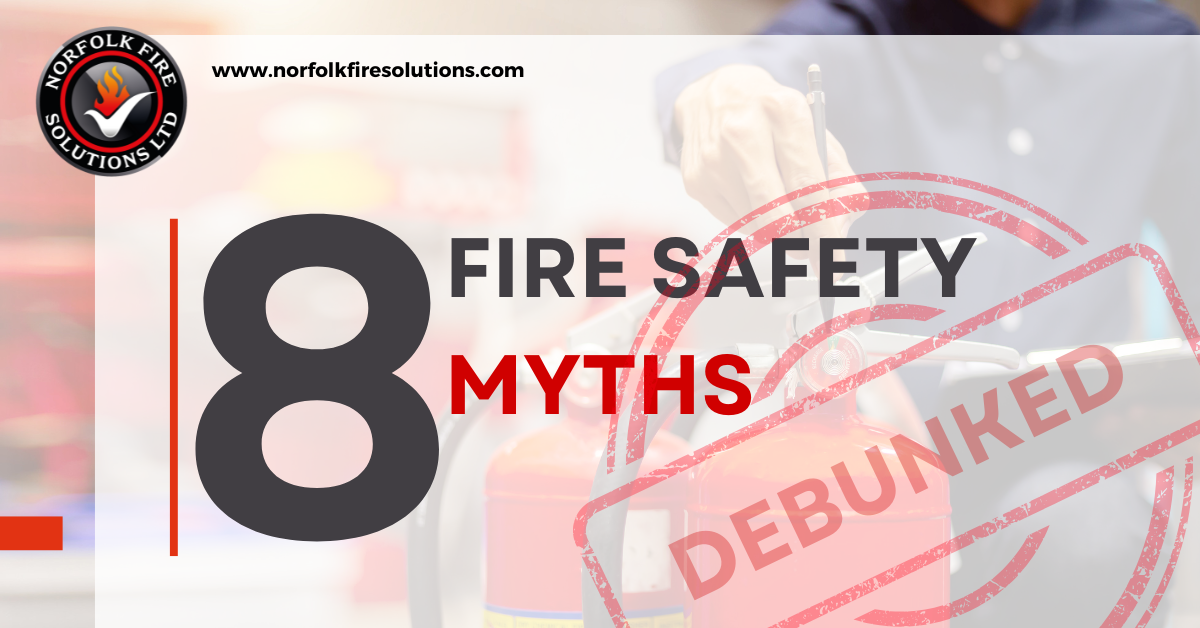8 Myths About Fire Safety for Businesses – Debunked
8 Myths About Fire Safety for Businesses – Debunked

When it comes to fire safety, there’s no room for misinformation. Yet, myths and misconceptions often circulate, leading to dangerous decisions or a false sense of security. To help businesses and individuals stay informed and prepared, let’s tackle some of the most common fire safety myths, and the truths behind them.
Myth 1: Sprinklers Cause More Damage Than Fire
Many believe that sprinklers will soak an entire building, causing extensive water damage, even for a small fire.
The Truth:
Sprinkler systems are designed to activate only in the area of the fire. In fact, 90% of fires are controlled by just one or two sprinkler heads. The water used by sprinklers is far less damaging than the fire itself, or the thousands of litres firefighters might need if the fire spreads.
Myth 2: Fire Extinguishers Are One-Size-Fits-All
It’s a common assumption that any fire extinguisher can be used to put out any type of fire.
The Truth:
Using the wrong extinguisher can make a fire worse. For example:
- A water extinguisher on an electrical fire could cause electrocution.
- A foam extinguisher may not be effective on flammable metals. It’s crucial to match the extinguisher to the fire type and train your staff accordingly.
Myth 3: I Don’t Need to Worry About Fire Safety Because I’m Insured
Some believe that having insurance means they don’t need to invest in extensive fire safety measures.
The Truth:
Insurance may cover property damage, but it won’t:
- Protect your staff and customers from harm.
- Prevent business interruption or loss of clients.
- Save you from legal penalties for non-compliance with fire safety regulations. Fire safety isn’t just about money, it’s about protecting lives and continuity.
Myth 4: Fire Alarms Are Enough
It’s a common misconception that as long as you have fire alarms, you’re fully protected.
The Truth:
Fire alarms are essential, but they’re just one part of a comprehensive fire safety strategy. Without:
- Clear evacuation plans,
- Emergency LED lighting, and
- Proper fire-fighting equipment, an alarm alone won’t help people escape safely or control the fire.
Myth 5: Fire Safety Is a “Set It and Forget It” Task
Some think that once fire extinguishers, alarms, and sprinklers are installed, there’s no need for further action.
The Truth:
Fire safety equipment requires regular maintenance and testing. For example:
- Fire extinguishers should be inspected annually.
- Fire alarms need weekly tests.
- Risk assessments must be updated whenever significant changes occur in the workplace.
Myth 6: It’s Safer to Evacuate and Let the Fire Brigade Handle It
While evacuation is critical, there’s a misconception that attempting to extinguish a fire before leaving is always unsafe.
The Truth:
If it’s a small fire and you’ve been trained, using the appropriate extinguisher can prevent the fire from spreading and causing more damage. Knowing when and how to act is key—if it’s beyond your control, evacuate immediately.
Myth 7: Modern Buildings Don’t Catch Fire Easily
Some assume that new buildings, designed with modern materials and technologies, are immune to fires.
The Truth:
While newer buildings may have better fire-resistant features, they are not fireproof. Electrical faults, human error, or flammable materials can still cause fires, making fire safety precautions just as critical.
Myth 8: Small Businesses Don’t Need Comprehensive Fire Safety Plans
Many small business owners believe that fire safety regulations primarily apply to larger organisations.
The Truth:
The Regulatory Reform (Fire Safety) Order 2005 applies to all non-domestic premises, regardless of size. Even small businesses are required to:
- Conduct fire risk assessments.
- Provide fire safety training.
- Maintain fire equipment.
Conclusion: Knowledge Saves Lives
Believing in fire safety myths can lead to costly mistakes and put lives at risk. By understanding the facts, businesses and individuals can take smarter, safer actions when it comes to fire prevention and response.
Don’t let myths shape your fire safety strategy. Stay informed, train your team, and regularly review your fire safety measures to ensure your workplace is prepared for any emergency.
Want to ensure your fire safety strategy is based on facts, not myths? Contact us for expert advice, training, and solutions tailored to your business.
